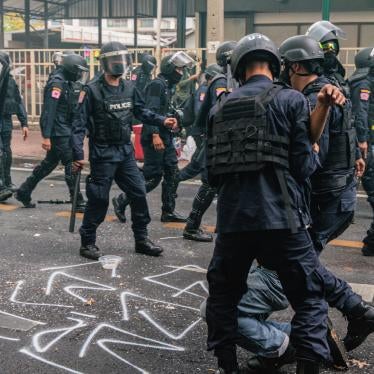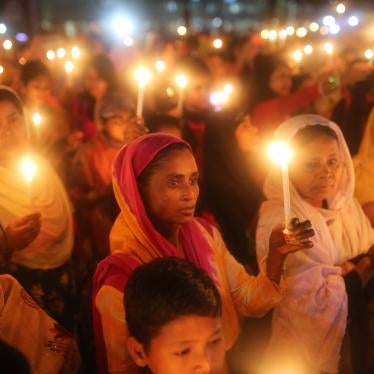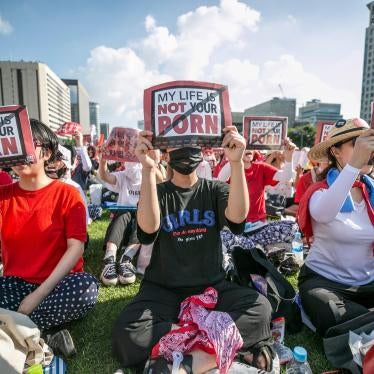The Honorable Patricia Guerrero, Chief Justice
And the Honorable Associate Justices
Supreme Court of California
350 McAllister Street
San Francisco, CA 94102
Re: Amicus Curiae Letter in Support of Petition for Review
Disability Rights California v. Gavin Newsom, No: S278330
Dear Chief Justice Guerrero and Associate Justices:
Pursuant to California Rules of Court Rule 8.500(g), amicus Human Rights Watch submits this letter respectfully requesting that the Court grant Disability Rights California’s petition for writ of mandate in Disability Rights California v. Gavin Newsom. This case presents a pressing issue with a wide-reaching impact: the CARE Act’s framework poses unacceptable threats to the human rights of Californians living with disabilities and will exacerbate existing racial disparities in housing and mental health systems. Human Rights Watch urges this Court to grant review and prevent the CARE Act from creating a system of control that will deprive many Californians of their fundamental human rights.
IDENTITY AND INTEREST OF AMICUS CURIAE
Human Rights Watch (“HRW”) is a non-profit, non-partisan organization established in 1978 that investigates and reports on violations of fundamental human rights in over 100 countries worldwide with the goal of securing the respect of these rights for all persons. It is the largest international human rights organization based in the United States. Human Rights Watch has filed amicus briefs before various bodies, including the U.S. Supreme Court, U.S. courts of appeal, and the Inter-American Commission on Human Rights. Human Rights Watch consistently advocates for the rights of unhoused community members and people living with disabilities to due process, equal protection, self-determination, and dignity. Given this interest and experience, Human Rights Watch is uniquely positioned to offer perspective regarding the human rights deprivations and related impacts that will occur should the CARE Act proceed.
GROUNDS FOR REVIEW
Original jurisdiction in this Court is merited when the matters to be decided are of sufficiently great importance and require immediate resolution. A long list[1] of disability, racial justice, peer-led, and other civil and human rights groups publicly oppose the CARE Act. The costly plan imposes coercive, court-ordered treatment, perpetuates structural racism, and conflicts with evidence-based solutions to ending houselessness. This is an important issue of first impression as this is a newly enacted statute that has not yet been interpreted. Absent speedy intervention from this Court, the CARE Act will cause great harm to thousands of people living in California.
For the reasons described below, Human Rights Watch respectfully asks the California Supreme Court to grant the petition for review.
- The CARE Act violates due process and will lead to erroneous deprivations of fundamental human rights, including the right to health.
Under the CARE Act, an expansive group of petitioners, including roommates, family members, first responders, police officers, homeless outreach workers, public guardians, conservators, service providers and the director of the county behavioral health agency, have the power to force a person into the jurisdiction of the CARE courts without the person’s consent or knowledge. [2] Troublingly, many of these petitioners may not possess any expertise on identifying signs and symptoms of mental health conditions.
The broad categories of petitioners not only lack relevant knowledge but raise the specter of abuse. For instance, interpersonal conflicts between family members could result in abusive parents, children, spouses, or siblings vindictively using the referral process to expose their relatives to court hearings and potential coerced treatment, housing, and medication.
Aside from the risk of abuse embedded in filing a petition, there is also the possible impact of a threatened petition. Law enforcement and outreach workers may threaten unhoused people with referral to the CARE court process created by the CARE Act to pressure them to move from a given area. Even if these state actors do not then unilaterally funnel those who disobey their commands into the CARE court process, the mere threat of a petition could repeatedly traumatize and disrupt a person’s life and community. Given the long history of law enforcement using its authority to traumatize and drive unhoused people from public spaces, it is dangerous to provide them with additional powers to do so.[3]
If after a merits hearing on the petition, the court finds the person meets the CARE Act criteria, the person is then required to enter into negotiations with the county behavioral health agency to come up with a purportedly voluntary agreement.[4] However, failure to agree to that nominally voluntary plan results in a court-ordered clinical evaluation by that same behavioral health agency, which can be used to impose a CARE plan following a hearing on the evaluation and other evidence.[5]
The CARE plan may include an order requiring engagement in clinical behavioral health care; counseling; specialized psychotherapies, programs, and treatments; stabilization medications; and priority access for certain housing resources.[6] This approach not only robs individuals of dignity and autonomy but is also coercive and likely ineffective.[7] Studies of coercive mental health treatment have generally not shown positive outcomes.[8] Evidence does not support the conclusion that involuntary outpatient treatment is more effective than intensive voluntary outpatient treatment and, indeed, shows that involuntary, coercive treatment is harmful.[9]
If a person does not complete the CARE Act process, the court may “involuntarily reappoint[ ]” them to the program for an additional year.[10] The court may use failure to comply with the CARE plan as “a presumption at that hearing that the respondent needs additional intervention beyond the supports and services provided by the CARE plan.”[11]
In practical effect, the mandatory care plans are simply pathways to the even stricter system of control through conservatorship, which may strip a person of their legal capacity and personal autonomy, subjecting them to forcible medical treatment and medication, loss of personal liberty, and removal of power to make decisions over the conduct of their own lives.[12]
This process is entirely coercive, despite procedures that claim it to be voluntary. Welfare and Institutions Code section 5801(b)(5), as amended by the CARE Act, makes this coercion clear. It reads: "The client should be fully informed and volunteer for all treatment provided, unless… the client is under a court order for CARE pursuant to Part 8 (commencing with Section 5970) and, prior to the court-ordered CARE plan, the client has been offered an opportunity to enter into a CARE agreement on a voluntary basis and has declined to do so."[13]
Under international human rights law, all people have the right to the highest attainable standard of physical and mental health.[14] Free and informed consent, including the right to refuse treatment, is a core element of that right to health.[15] Having a “substitute” decision-maker, including a judge, make orders for health care can deny a person with disabilities their right to legal capacity and infringe on their personal autonomy.[16]
The Convention on the Rights of Persons with Disabilities (CRPD) obligates State parties to “holistically examine all areas of law to ensure that the right of persons with disabilities to legal capacity is not restricted on an unequal basis with others. Historically, persons with disabilities have been denied their right to legal capacity in many areas in a discriminatory manner under substitute decision-making regimes such as guardianship, conservatorship and mental health laws that permit forced treatment.”[17] The US has signed but not yet ratified this treaty, which means it is obligated to refrain from establishing policies and legislation that will undermine the object and purpose of the treaty.[18] Mandating long-term substitute decision-making schemes like conservatorship or court-ordered treatment plans would defeat the object and purpose of the CRPD, which is to provide persons with disabilities full recognition as rights holders. People’s right to make their own decisions, regardless of the support requirements they might have, instead of being considered as objects of rehabilitation, is a core component of the CRPD.
The World Health Organization has developed a new model that harmonizes mental health services and practices with international human rights law and has criticized practices promoting involuntary mental health treatments as leading to violence and abuse, rather than recovery, which should be the core basis of mental health services.[19] Recovery means different things for different people, but one of its key elements is having control over one´s own mental health treatment, including the option to refuse treatment.
To comply with human rights, treatment should be based on the will and preferences of the person concerned. Housing or disability status does not remove a person’s right to legal capacity or personal autonomy. Expansive measures for imposing mental health treatment like the process envisioned by the CARE Act infringe on this right and discriminate on the basis of disability.
- The CARE Act violates Equal Protection and targets unhoused and BIPOC community members.
The CARE Act directly targets unhoused people to be placed under court-ordered treatment, thus denying their rights and self-determination. Governor Newsom, in pitching this plan, called it a response to seeing homeless encampments throughout the state of California.[20]
Despite allusions to “housing plans,” the housing ordered by a CARE plan may be inadequate. Housing must be provided through a designated list of existing programs that include interim housing or shelter options that may be unacceptable to an individual and unsuited to their unique needs.[21] The CARE Act also does not enforce housing prioritization for its graduates in the long-term and the graduation plan cannot “place additional requirements on local government entities.”[22] Under the CARE Act, there is no guarantee the person will not become unhoused again, even if they undergo all its provisions.
International human rights law enshrines the right to adequate housing. This right is recognized in the Universal Declaration of Human Rights,[23] which is widely accepted as reflective of customary international law. It is also recognized by the International Covenant on Economic, Social, and Cultural Rights (ICESCR).[24] The US has not ratified the ICESCR, but as a signatory it is obligated to refrain from actions that undermine the treaty’s object and purpose.[25]
According to the Committee on Economic, Social, and Cultural Rights (CESCR)—the expert body charged with interpreting and monitoring state compliance with the ICESCR—the “right to housing cannot be viewed in a narrow or restrictive sense.” Rather it should be understood as the “right to live somewhere in security, peace and dignity,” and must be “ensured to all persons irrespective of income.”[26] This right to housing must be guaranteed to everyone, without distinction as to race, colour or national or ethnic origin.[27]
Due to a long history of racial discrimination in housing, employment, access to health care, policing, and the criminal legal system, Black, Indigenous, and People of Color (BIPOC) communities have much higher rates of houselessness than their overall share of the population.[28] The CARE Act in no way addresses the conditions that have led to these high rates of houselessness. Instead, it proposes a system of state control over individuals that will disproportionately impact Californians of color.
Further, the CARE Act singles out people with “schizophrenia spectrum and other psychotic disorders.”[29] Research shows that due to bias, misinterpretation of trauma, and a lack of cultural competency, mental health professionals over-diagnose and misdiagnose Black and Latino populations with these conditions at much higher rates than they do white populations.[30] One meta-analysis of over 50 separate studies found that Black people are diagnosed with schizophrenia at a rate nearly 2.5 times greater than white people.[31] A 2014 review of empirical literature on the subject found that Black people were diagnosed with psychotic disorders three to four times more frequently, and Latino people approximately three times more frequently, than white people.[32]
Under the International Covenant on Civil and Political Rights (ICCPR), which the United States has ratified, all persons are equal before the law and are entitled without any discrimination to the equal protection of the law.[33] The International Covenant on the Elimination of Racial Discrimination (ICERD), which the US has similarly ratified, requires each State Party to engage in no act or practice of racial discrimination against persons, groups of persons or institutions.[34] ICERD further imposes the obligation that parties take effective measures to amend, rescind, or nullify any laws that have the effect of creating or perpetuating racial discrimination.[35]
CONCLUSION
For the foregoing reasons, amicus request that this Court grant the petition for review in Disability Rights California v. Gavin Newsom.
DATED: February 17, 2023
Respectfully submitted,
/s/ John Raphling
John Raphling (SBN 169554)
Human Rights Watch
11500 W. Olympic Blvd., Ste. 608
Los Angeles, CA 90064
Phone Number: 310-351-0272
raphlij@hrw.org
[1] Open Letter to Governor Newsom in Opposition to CARE Court, Human Rights Watch (Aug. 11, 2022), https://www.hrw.org/news/2022/08/16/open-letter-governor-newsom-opposition-care-court.
[2] The Community Assistance, Recovery, and Empowerment (“CARE”) Act, Stats 2022, Ch. 319 §§ 5974, 5978 (Sept. 14, 2022).
[3] Chris Herring, Complaint-Oriented Policing: Regulating Homelessness in Public Space, 84 Am. Socio. Rev. 769-80 (2019).
[4] Community Assistance, Recovery, and Empowerment Act § 5977.
[5] Id. §§ 5977.1c-5977.1d.
[6] Jud. Council of Cal., Invitation to Comment Rules and Forms: Community Assistance, Recovery, and Empowerment Act 20 (2023), https://www.courts.ca.gov/documents/w23-10.pdf; Community Assistance, Recovery, and Empowerment Act §§ 5982a, 5970.5.
[7] S.P. Sashidharan et al., Reducing Coercion in Mental Healthcare 28 Epid. & Psych. Sci. 606 (2019) (“Available research does not suggest that coercive intervention in mental health care are clinically effective, improve patient safety or result in better clinical or social outcomes.”).
[8] Reducing Coercion in Mental Healthcare at 605-12; Richard M. Ryan et al., Motivation and Autonomy in Counseling, Psychotherapy, and Behavior Change: A Look at Theory and Practice, 39 Invited Integrative Rev. 193-260 (2011); Paul McLaughlin et al, Use of Coercive Measures During Involuntary Psychiatric Admission and Treatment Outcomes: Data from a Prospective Study Across 10 European Countries, 11 PLoS One 6 (2016) (“All coercive measures are associated with patients staying longer in hospital, and seclusion significantly so, and this association is not fully explained by coerced patients being more unwell at admission.”).
[9] Joseph P. Morrissey et al, Outpatient Commitment and Its Alternatives: Questions Yet to Be Answered, 65 Psych. Services (2014); Reducing Coercion in Mental Healthcare at 605-612.
[10] Community Assistance, Recovery, and Empowerment Act §§ 5977.3b-5977.3c.
[11] Id. § 5979a.
[12] Community Assistance, Recovery, and Empowerment Act § 5979a; California Welfare & Institutions Code §§ 5350-5372.
[13] Community Assistance, Recovery, and Empowerment Act §5801b5.
[14] International Covenant on Economic, Social and Cultural Rights, art. 12 Dec. 16, 1966, 993 U.N.T.S. 3 (entered into force January 3, 1976).
[15] UN Human Rights Council, Report of the Special Rapporteur on the Right of Everyone to the Enjoyment of the Highest Attainable Standard of Physical and Mental health, ¶ 63, U.N. Doc. A/HRC/35/21 (March 28, 2017). See also Convention on the Rights of Persons with Disabilities, art. 12, 25, Dec. 13, 2006, 2515 U.N.T.S. 3 (entered into force May 3, 2008); Committee on the Rights of Persons with Disabilities, General Comment No. 1 (Article 12: Equal recognition before the law), ¶¶ 31, 41, U.N. Doc. CRPD/C/GC/1 (Mar. 31-April 11, 2014).
[16] CRPD art. 12; Committee on the Rights of Persons with Disabilities, General comment No. 1, ¶ 7.
[17] Committee on the Rights of Persons with Disabilities, General comment No. 1, ¶ 7.
[18] See Vienna Convention on the Law of Treaties (VCLT), art. 18 May 23, 1969, 1155 U.N.T.S. 33.
[19] World Health Organization & Quality Rights, Freedom from Coercion, Violence, and Abuse,2, 8, 22 (2019),https://apps.who.int/iris/bitstream/handle/10665/329582/9789241516730-eng.pdf?sequence=5&isAllowed=y.
[20] Maria Lagos, Gov. Newsom on His Plan to Tackle Mental Health, Homelessness with ‘CARE Courts, KQED (Mar. 16, 2022 10:00 AM), https://www.kqed.org/forum/2010101888316/gov-newsom-on-his-new-plan-to-tackle-mental-health-homelessness-with-care-courts.
[21] Community Assistance, Recovery, and Empowerment Act § 5982a; Cal. Health & Human Services Agency, CARE (Community Assistance, Recovery and Empowerment) Court (2022), https://www.chhs.ca.gov/wp-content/uploads/2022/12/CARE-Act-Overview_ADA-Compliant.pdf. (discussing a range of housing possibilities including “interim or bridge housing,” which in common usage means temporary shelter).
[22] Community Assistance, Recovery, and Empowerment Act § 5977.3.
[23] Universal Declaration of Human Rights, art. 25 Dec. 10, 1948, G.A. Res. 217A(III), U.N. Doc. A/810.
[24] International Covenant on Economic, Social and Cultural Rights, art. 11 Dec. 16, 1966, 993 U.N.T.S. 3 (entered into force January 3, 1976).
[25] See VCLT art. 18.
[26] Committee on Economic, Social, and Cultural Rights, General Comment No. 4 (The Right to Adequate Housing), ¶ 7, U.N. Doc. E/1992/23 (Dec. 9, 1991).
[27]International Convention on the Elimination of All Forms of Racial Discrimination, art. 5, Dec. 21, 1965, S. Exec. Doc. C, 95-2 (1978), S. Treaty Doc. 95-18, 660 U.N.T.S. 195.
[28] Kate Cimini, Black People Disproportionately Homeless in California, CalMatters (February 27, 2021), https://calmatters.org/california-divide/2019/10/black-people-disproportionately-homeless-in-california/ (about 6.5% of Californians identify as black or African American, but they account for nearly 40% of the state’s homeless population); Esmeralda Bermudez & Ruben Vives, Surge in Latino Homeless Population ‘a Whole New Phenomenon for Los Angeles, L.A. Times (June 18, 2017), https://www.latimes.com/local/california/la-me-latino-homeless-20170618-story.html; Los Angeles Homeless Services Authority, Report and Recommendations of the Ad Hoc Committee on Black People Experiencing Homelessness (Dec. 2018), https://www.lahsa.org/documents?id=2823-report-and-recommendations-of-the-ad-hoc-committee-on-black-people-experiencing-homelessness.
[29]Community Assistance, Recovery, and Empowerment Act § 5972b.
[30]Charles M Olbert et al., Meta-analysis of Black vs. White Racial Disparity in Schizophrenia Diagnosis in the United States: Do Structured Assessments Attenuate Racial Disparities?, 127 J. Abnormal Psychology 104- 15 (2018); Robert C. Schwartz & David M. Blankenship, Racial Disparities in Psychotic Disorder Diagnosis: A Review of Empirical Literature,” World J. Psych. 4 133-40 (2014).
[31] Meta-analysis of Black vs. White Racial Disparity in Schizophrenia Diagnosis at 104- 15.
[32] Racial Disparities in Psychotic Disorder Diagnosis at 133-40.
[33] International Covenant on Civil and Political Rights (ICCPR) art. 26, Dec. 16, 1966, 999 U.N.T.S. 171 (entered into force Mar. 23, 1976).
[34] ICERD art. 2(1)(a).
[35] Id. art. 2(1)(c).







